How to Create an Effective Product Launch Strategy

Sorry, there were no results found for “”
Sorry, there were no results found for “”
Sorry, there were no results found for “”
Getting products to market is complicated. Naturally, you have to consider what types of products your customers want. But you also have to balance budgets, manage marketing efforts, and create processes to support sales teams. 💸
One way to ensure success is to build an effective product launch strategy, which involves generating input from various departments, conducting tests, and assembling teams and tasks.
Here, we’ll dive deeper into the importance of product launch strategies along with some common pitfalls to avoid. We’ll also share a step-by-step process for creating an effective product launch strategy that sets you up for success. 🤩
A product launch strategy is a well-thought-out plan to bring a new product to a target market. A great example of this is Apple’s Keynote events where the brand introduces and reviews one of its products (such as the latest iPhone) in front of a live audience.
Product launch strategies involve several steps across departments—it starts with doing market research and setting product goals. Such a plan also typically includes a roadmap, timeline, and workflows to stay organized and optimize your go-to-market strategies. 🎯
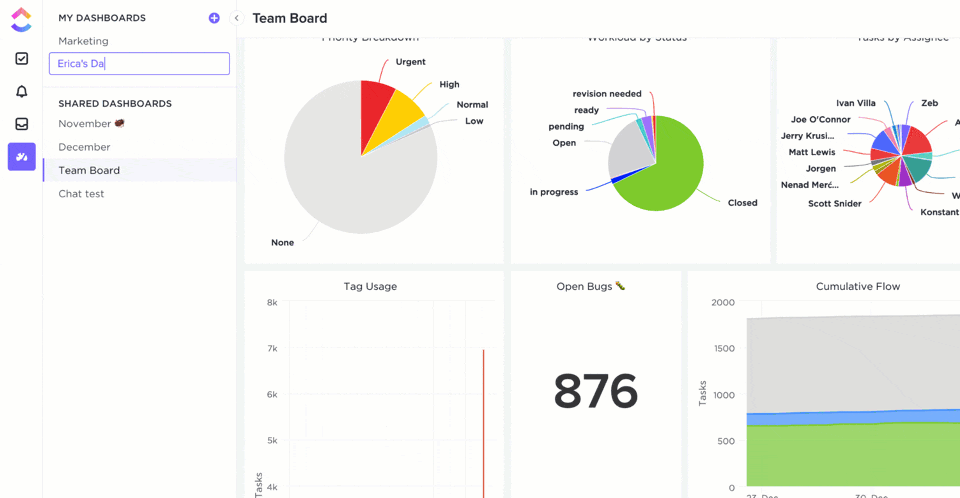
In addition to internal processes, product launch strategies cover external outreach, such as building brand awareness and promoting the product to potential customers. You can then track KPI (key performance indicators) to monitor progress, gain meaningful insights, and improve your strategies based on the data you glean.
A product launch strategy is crucial as it’s a key component of building brand awareness. It shows your target market that you understand their pain points and create products they need or want. It also establishes your business as an industry leader, offering cutting-edge products and services.
A successful product launch can also garner attention from investors, which can lead to better business deals and lucrative partnerships for future products. 💰
Indeed, product launch strategies can improve your bottom line. With a seamless plan from product development to market launch, you can reduce resource waste and improve capacity across departments. Plus, customers are more likely to make a purchase thanks to a strong product launch that demonstrates its usefulness and appeal.
Creating a product launch strategy requires a methodical and organized approach to ensure success. Here are some of the most common pitfalls in product launch strategies to avoid. 🚫
You can’t assume your product idea is going to be a big hit, even if you love it. You must spend time researching your target audience and the product market to determine if it’s a good fit for consumers. Even if it’s a good product, it might not be something your target audience wants.
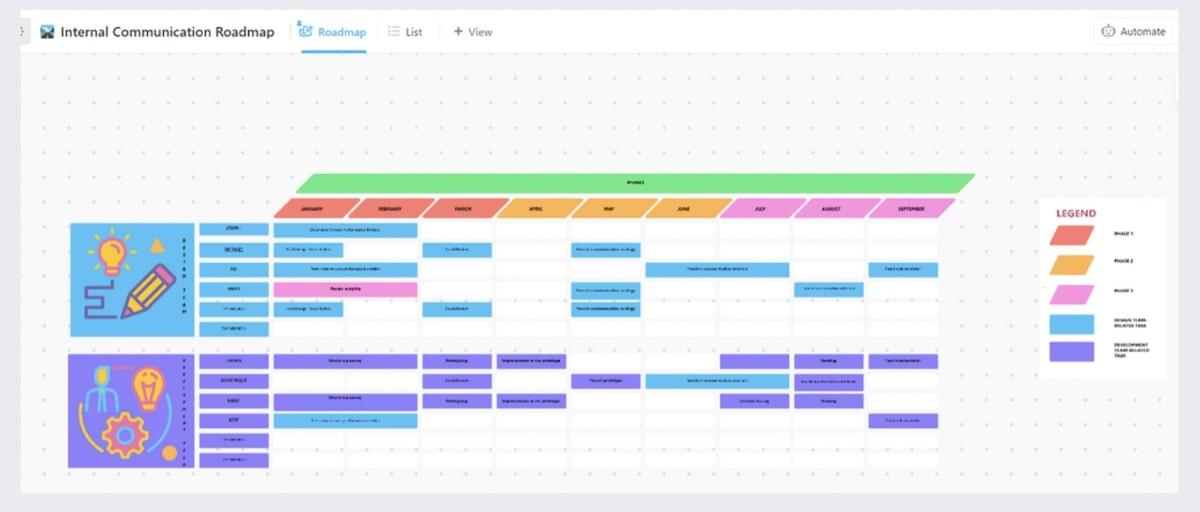
A key reason why a product launch process might fail is a lack of planning—especially when multiple departments are involved and no one’s on the same page. Sometimes the goals set initially don’t meet the scope of the project. Other times, projects get bogged down due to poor workflows. Communication gaps can also delay product launches or cause overall failure.
With product launches, an effective marketing strategy is a critical component of success. If you don’t market your product properly, your target audience simply won’t learn about it.
HubSpot’s 2024 State of Sales Report found that new customers account for only 28% of sales. This underscores the importance of knowing your audience when promoting a product—and focusing on existing customers who can drive sales.
In today’s digital age, you have to find ways to set your products above the rest. The best way to do that is to use your product to tell a story. After all, people buy products not just because they need them, but because they like the people and story behind them. 💪
Creating a product launch strategy involves coordination and clear planning across the entire marketing team. With this step-by-step guide, you can lay the groundwork for product launch success. Plus, you can take these product strategies and customize them to fit the needs of your business.
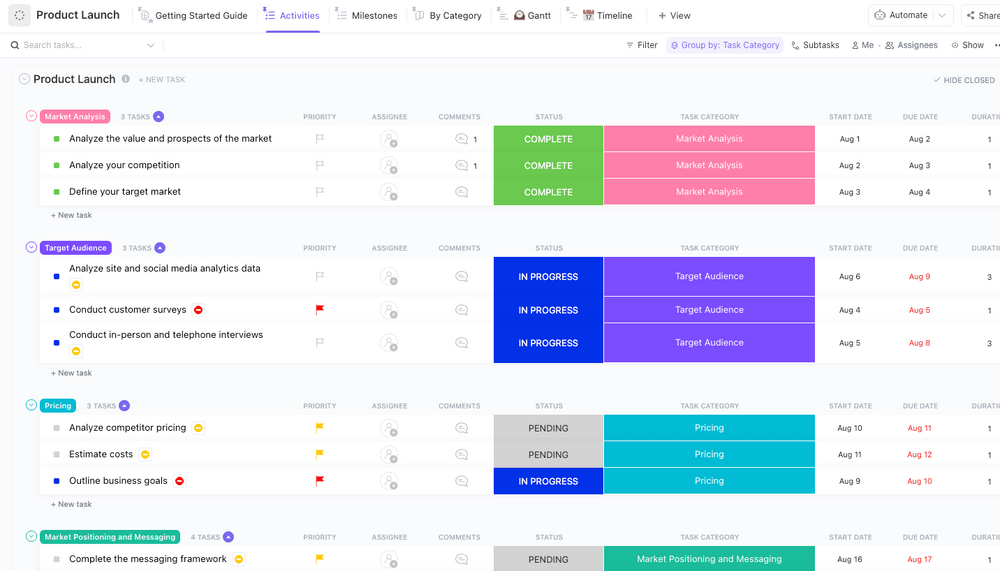
Product launches get complicated quickly. Stay organized and keep track of everything on your to-do list for a successful launch with ClickUp’s Product Launch Checklist Template. When you start with a clear list of everything you need to get done, you’re less likely to have things fall through the cracks. ✍️
This template streamlines product management thanks to several different views—including a list of all planned activities, a timeline, and a Gantt chart. Use it to build the basic processes of your product launch and add custom fields for details relevant to your products and business.
ClickUp also features hundreds of other templates including product development templates to ideate and create products users need.
There are also plenty of free product launch templates that simplify the process of building a roadmap to launch day and automate workflows for increased capacity.
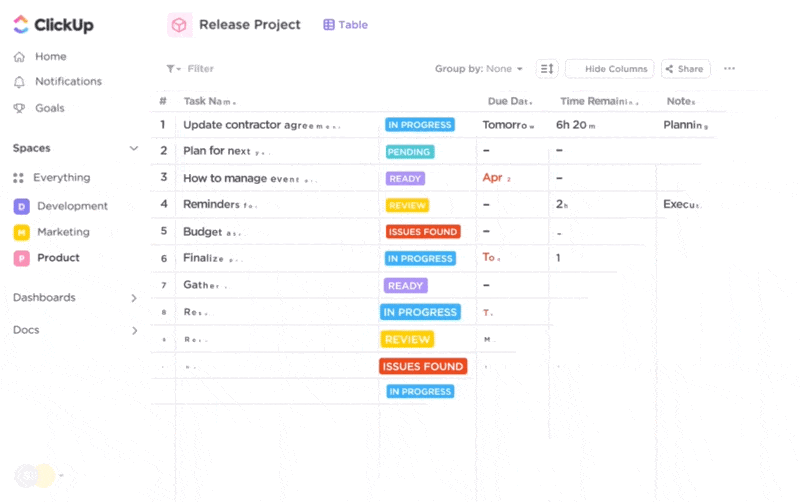
Use task management software like ClickUp to streamline and automate your product launch processes. Not only will this tool save you time and money, but it’ll also help you identify work capacity and simplify workflows. That means all your teams are working synchronously towards the product goal. 🙇
ClickUp for Product Teams lets you ship products faster and more effectively. Built-in dashboards provide overviews for all launch activities while issue tracking and sprint management features keep things moving smoothly.
Visualize the entire product life cycle whether you want to hone in with a specific team-level view or see a snapshot of tasks remaining before launch. Real-time collaboration in Docs and Whiteboards makes it easy to review market research, scope out products, and brainstorm solutions. 💡
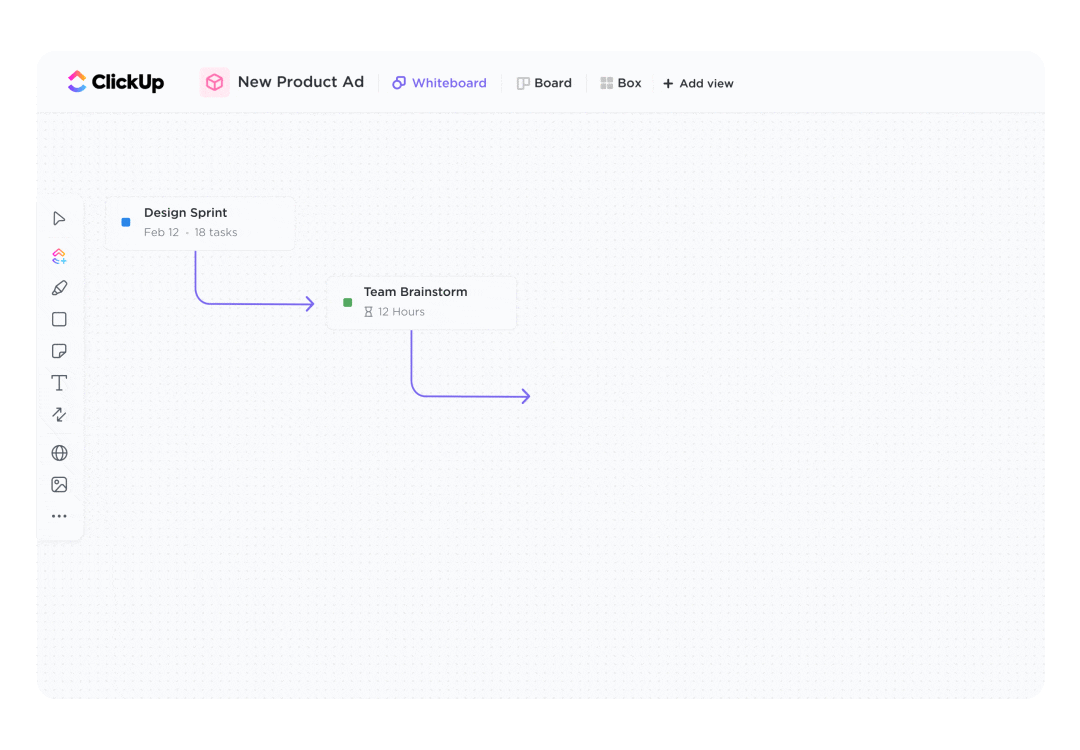
Knowing your target audience is integral for a successful product launch. Research everything from demographics to common questions and pain points to learn more about your users.
To do this, develop detailed buyer personas to better understand what types of products your customers are looking for. That means tuning into what motivates them, what pain points they experience using existing products, and what new features they’ve requested in the past.
You’ll also want to use segmentation to break prospective customers into smaller target groups. For instance, you could group buyers based on demographics (like age, income, and education level), where they live, what their interests are, and what industries they work in.
The same goes for the actual product development process. For instance, a 2.0 version of an existing product may not make sense or be the best approach. Do market research to ensure there’s a need or demand for the product you want to launch.

Your launch plan should include steps for prototypes and beta testing. This type of research provides on-the-ground insights based on customer feedback into how users truly feel about your proposed product. That lays the groundwork for an effective launch or a transition to a different product.
Be sure to understand the market including what similar products exist and identify gaps that your business can fill. At the end of this process, you should be able to define your ideal customer and build the overall product launch scope based on their needs as well as market conditions.

Without clear and effective goals, it’s easy to get sidetracked. Make sure you define specific goals for every launch phase from pre-launch to post-launch. Use a tool like ClickUp Goals to brainstorm objectives and track progress from start to finish. 📈
Use ClickUp Goals to set measurable targets and automate tracking for your product launch plan. Quickly set campaign metrics and KPIs with just a few clicks and choose from numerical, monetary, true/false, and task Targets to track progress.
Group your goals into folders to see multiple goals in one view. Use permissions to control access to goal setting and set deadlines for sprints to keep teams from all departments on track to launch day.
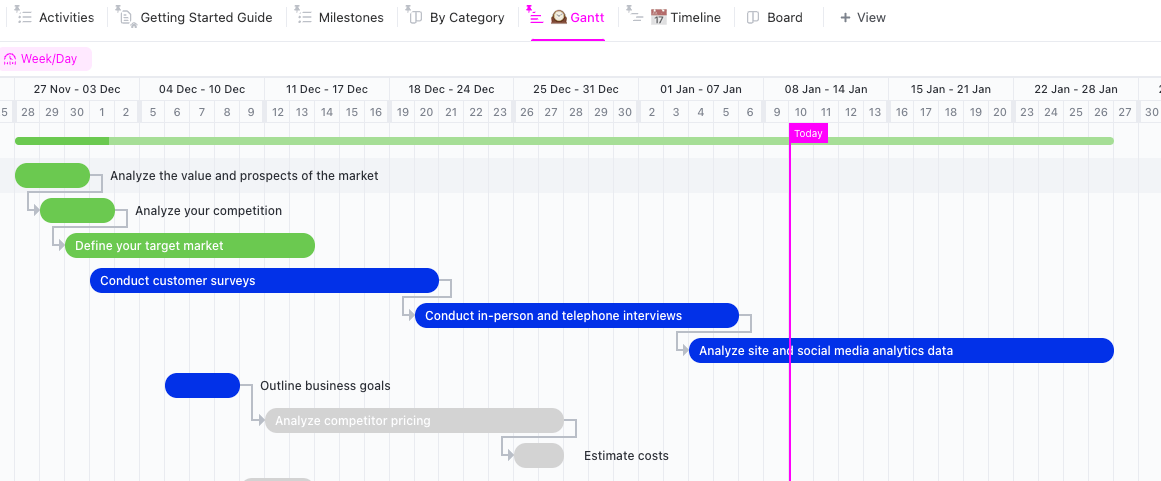
No product launch strategy is complete without a timeline and roadmap. After all, there’s no way to track progress if you don’t have a schedule to compare it to. Use the Gantt Chart View in ClickUp for planning a product roadmap and every task that needs to be completed before your launch date. 🗓️
The dynamic timeline lets you change dates, identify bottlenecks, and visualize progress for all launch activities in one simple view. Easy color-coding breaks down work by department or project, improving visibility across the entire business. Use priority flags to identify high-value work and use cascading views to see structured workflows.
Leverage the dozens of Gantt chart project templates to speed up this step. Just plug in the important information for your project and let the software do the rest by assigning tasks and automating due dates.
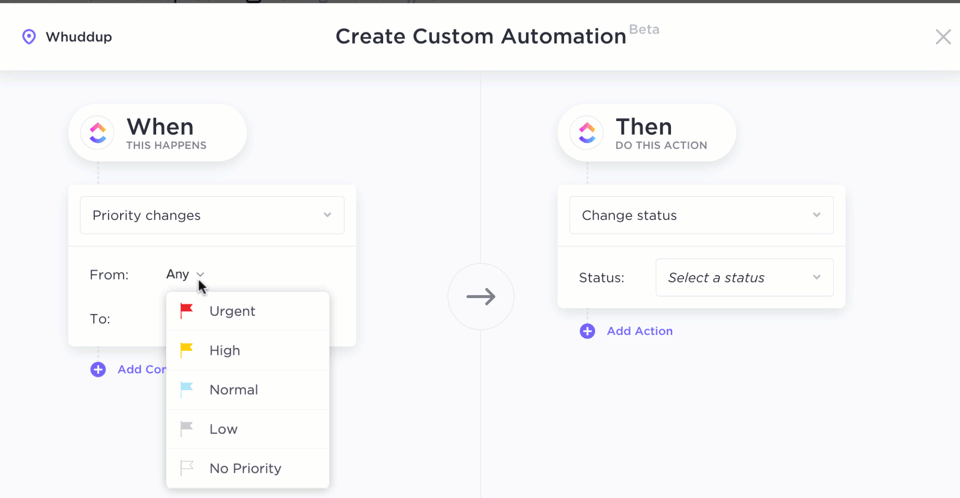
For a successful product launch, you need team members to be coordinated and working towards the same goals. Be clear when setting product launch goals and build workflows that are designed to meet those objectives. Create clear lines of communication across departments and ensure relevant stakeholders are notified if a roadblock arises.
Once you know what types of work will be involved in your product launch, you need to assign projects to team members and create tasks. Normally, this step takes a ton of time and involves plenty of busy work.
However, with ClickUp Automations you can save time and focus your efforts on more important work. Choose from more than 100 automations to handle routine tasks like project handoffs and streamline workflows.
Click Up Dependencies also simplify task management throughout the launch process. By creating links between tasks, you can quickly see what work needs to be done first and if any tasks are delaying the project. 👀
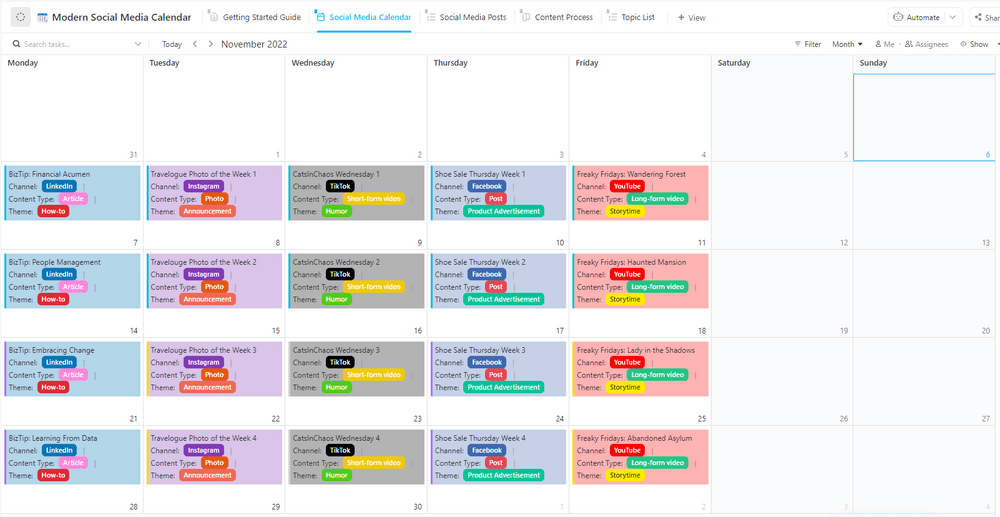
You can build a great product, but it won’t go anywhere if people don’t know about it. 🤷
That’s where an effective product launch strategy backed by marketing campaigns can increase conversion rates. By giving users the information they need right on product launch day, they can make informed decisions and feel better about making a purchase.
Leverage all marketing channels from social media posts to email marketing to get the word out. Put out press releases in advance of the product launch to generate interest. Reward early adopters with discounts, special features, or unique memberships.
For a new product launch, work with influencers to improve messaging and build word-of-mouth recommendations. Make sure your campaigns focus not just on functionality, but also on user experience and include vital information like pricing.
Your marketing plan should also focus on meeting customer’s needs. Host webinars to show customers how to use the product or highlight key features. Companies like Apple and Tesla do this well with keynote speeches when they unveil new products.
Use product marketing software to manage your campaigns in one convenient place whether you’re running email campaigns, digital marketing initiatives, or content marketing projects. 👨🏽💻
Remember, failure to do adequate marketing is one of the most common pitfalls of product launches. Be sure to build effective marketing teams to handle initiatives from start to finish.
Whether it’s creating a landing page for your new product or planning a product launch event, you’ll want to cast a wide net and focus on customer needs when doing outreach.
We’re more likely to buy products from brands we know. One Adobe study showed consumers are 71% more likely to buy from brands they trust.
By telling a story and connecting with potential customers, you build trust and brand recognition. They buy into your ideas and values and want to be a part of your success. That leads to better chances of customers making a conversion.
Start by setting a clear value proposition. That means highlighting why anyone would want to use or need your product more than your competitors’ products. The more creative you are, the more likely you are to make an impact with a successful launch. 🙌
Use content marketing to create a narrative around your product launch and support it with videos that are engaging for today’s audiences. Use emotional appeals and customer testimonials to build your brand and make connections with users.
With these tips and tricks, you’re well on your way to creating a successful product launch strategy. Do your due diligence to avoid common pitfalls, create a checklist to stay on track, and define clear, attainable goals to set up your team for success. The more effort you put in upfront, the smoother the launch process will go.
Sign up for ClickUp today and start managing workflows and automating processes for better product launches. From ideation and brainstorming to connecting with customers and tracking success, it’s never been easier to manage your projects in one place.
© 2025 ClickUp